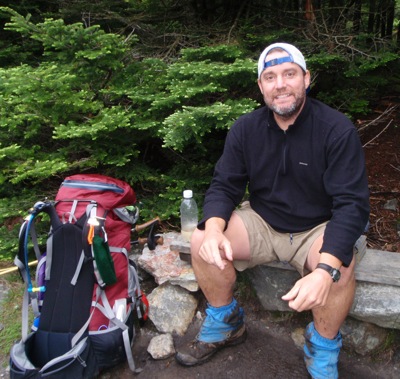Monday, January 25th, 2010
Just not many like 'Captain Blue'
Man with local family taking third trek on Appalachian trail
By Margie Wuebker

Submitted Photo
Andy Niekamp rests beside his backpack and other belongings on the summit of Stratton Mountain in Vermont.
MINSTER - Andy "Captain Blue" Niekamp belongs to a select group of individuals who have hiked the 2,179-mile Appalachian National Scenic Trail not once, but twice. And the information technology specialist has his sights set on completing a third hike later this year.
Niekamp took the Sunday afternoon audience at Minster Middle School on a picturesque trip along the ruggedly beautiful trail extending from Spring Mountain in Georgia to Mount Katahdin in Maine. Boulder-strewn in some places and well-vegetated in others, the trail maintained by dedicated volunteers courses through 14 states.
His passion for hiking dates back to Boy Scout days when a troop of Kettering-area boys and their Scout leaders embarked on hikes at scenic locations - state parks and nature preserves - not far from home. He began hiking in earnest 15 years ago and now at the age of 48, the son of Mercer County natives Janet Willke Niekamp (Maria Stein) and the late Andrew Niekamp (St. Henry) is hooked to the extent that he uses vacation and unpaid leave to return to the trail he affectionately calls A.T.
Niekamp considers himself a section hiker, averaging 500 to 600 miles per segment at the rate of 10 to 15 miles per day. He occasionally puts in exhausting days stepping off 27 miles during a single 24-hour period. Other enthusiasts fall into the categories of thru-hikers and flip-floppers. Thru-hikers start at the beginning and continue to the end, while flip-floppers may begin the trek northbound and at some point drive to the terminus in order to head southbound.
Statistics indicate more than 11,000 hikers have completed the trail once, with 125 repeating the grueling process a second time. Niekamp will join a select group of 30 or so enthusiasts to reach the finish line for the third time.
"There are four main reasons why A.T. hikers fail to achieve their goal," he said. "They are physical (their knees go bad or other problems develop), financial (they simply run out of money because you cannot subsist of berries and nuts), out of time and mental or unfulfilled expectations (the trip is not what they expected)."
The trail is marked with 2 x 6-inch vertical white paint blazes. A double blaze or one white mark above the other signifies turns, junctions or areas where hikers need to pay special attention. Blue blazes mark the site of alternative paths leading to shelters, water supplies or particularly scenic views. The signs number roughly 165,000.
Some 260 shelters offer places to sleep or a haven from the elements. The nicest shelter formerly housed fire service wardens, while the majority are of the three-sided variety with few amenities other than a nearby privy, a water source and a register in which to record one's trail name, comments on sights or experiences. Most shelters are designed to hold three to four people. However, there is a rule about making room for at least one more on rainy nights.
"One of the shelters I stayed at is reported to be haunted," he says. "Two women on the trail were murdered there. I was so tired there could have been 40 ghosts dancing around but I never would have known."
Bears and snakes are as much a part of the landscape as butterflies and deer. One section of the trail leads through a zoo where animals are safely ensconced behind sturdy fences. That is not the case elsewhere, and it behooves hikers to pay attention to their surroundings.
"I'm not afraid of bears in states with hunting seasons," he says. "They fear people as much as we fear them. They have no fear in states without hunters and guns. Believe me, the last thing you need is a bear encounter in camp late at night with no one around."
Niekamp generally embarks on his own and meets up with other hikers along the way. They tend to be a welcoming lot due to shared interests. He once met a Dayton man in a trail town and wound up having dinner that night with 11 other Montgomery County residents.
Trail towns provide motels, bed and breakfast sites, hiker hostels and occasionally a college fraternity basement. Sometimes the need for a hot shower and clean clothes is enough to take hikers such as Niekamp off the trail if only for a little while.
Guide books impart the history of the towns and pinpoint the location of restaurants, grocery stores, post offices, trail outfitters, laundromats and even libraries with Internet access. And cell phones with text capabilities provide a window to the outside.
"There are signs in the laundromats warning hikers towels are not suitable attire," he says with a chuckle. "The plan is to wash all your dirty clothes during a stop. I have learned to slip on my nylon rain suit and wash everything else."
Before embarking on the trail, Niekamp and other hikers prepare packages containing food, equipment, batteries and reference guides. They mail the boxes to themselves via general delivery at post offices along the route with a notation on expected pickup dates. They also send home unneeded items to lighten the load and thereby comply with a familiar hiker formula - "Less on is good, more on is moron."
He recalls memorable and frightening incidents that occurred on the trail. Despite wearing every stitch of clothes in his possession and carrying all his belongings, the tall, well-built hiker was blown over by gusty 60 mile per hour winds in Maine. The noise of his flapping rain jacket was louder than he could bear.
"There was one really scary time," he says quietly. "I had heat exhaustion and I remember falling down delirious in the dirt with mosquitos attacking like dive bombers. I managed to crawl into the shelter and later went into town. I spent two days sitting in air conditioning at a bed and breakfast before recovering physically and mentally."
Niekamp calls hiking the Appalachian Trail his personal fountain of youth and an inner journey that takes him far away from the day-to-day grind. That alone keeps him coming back year after year.


